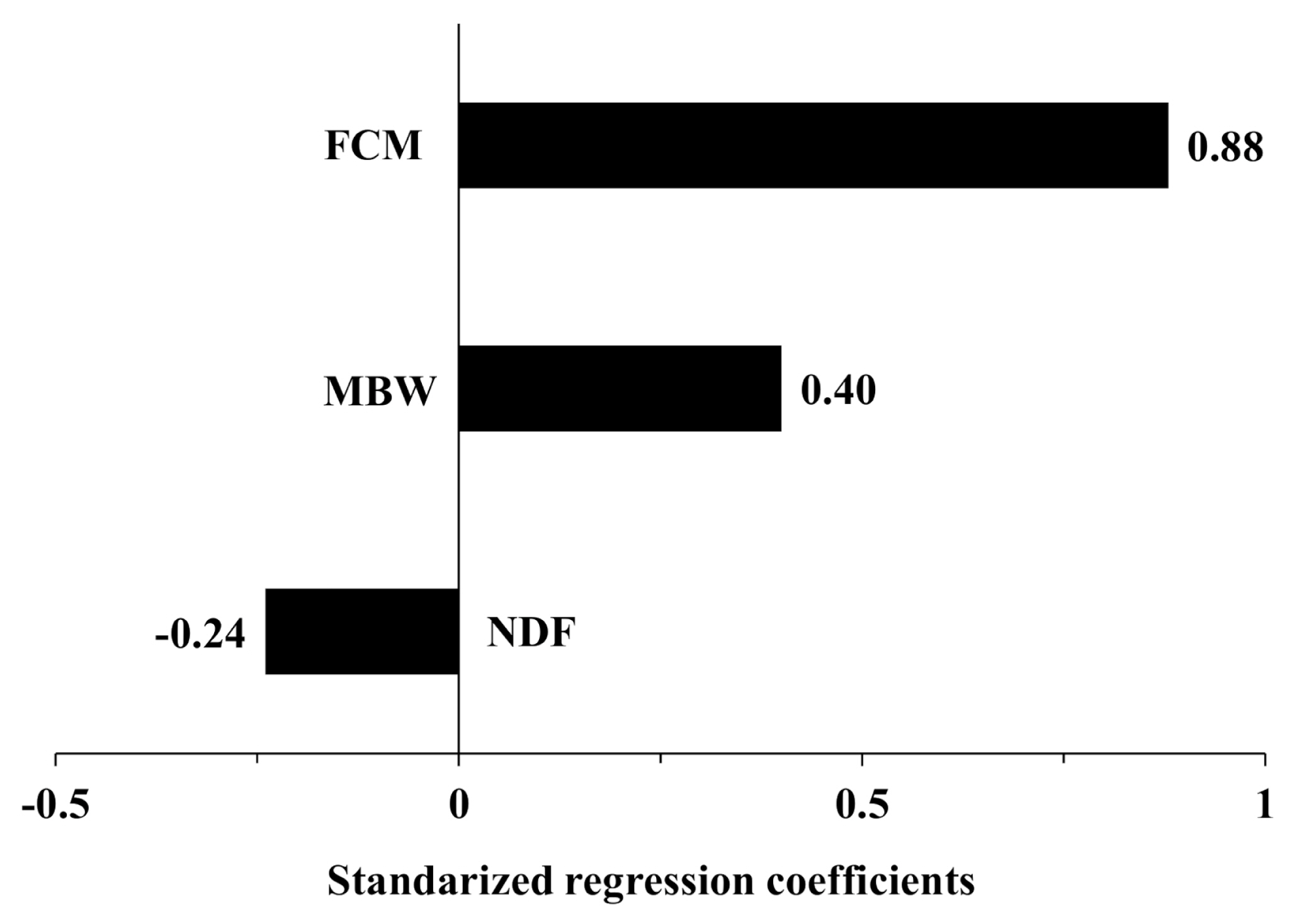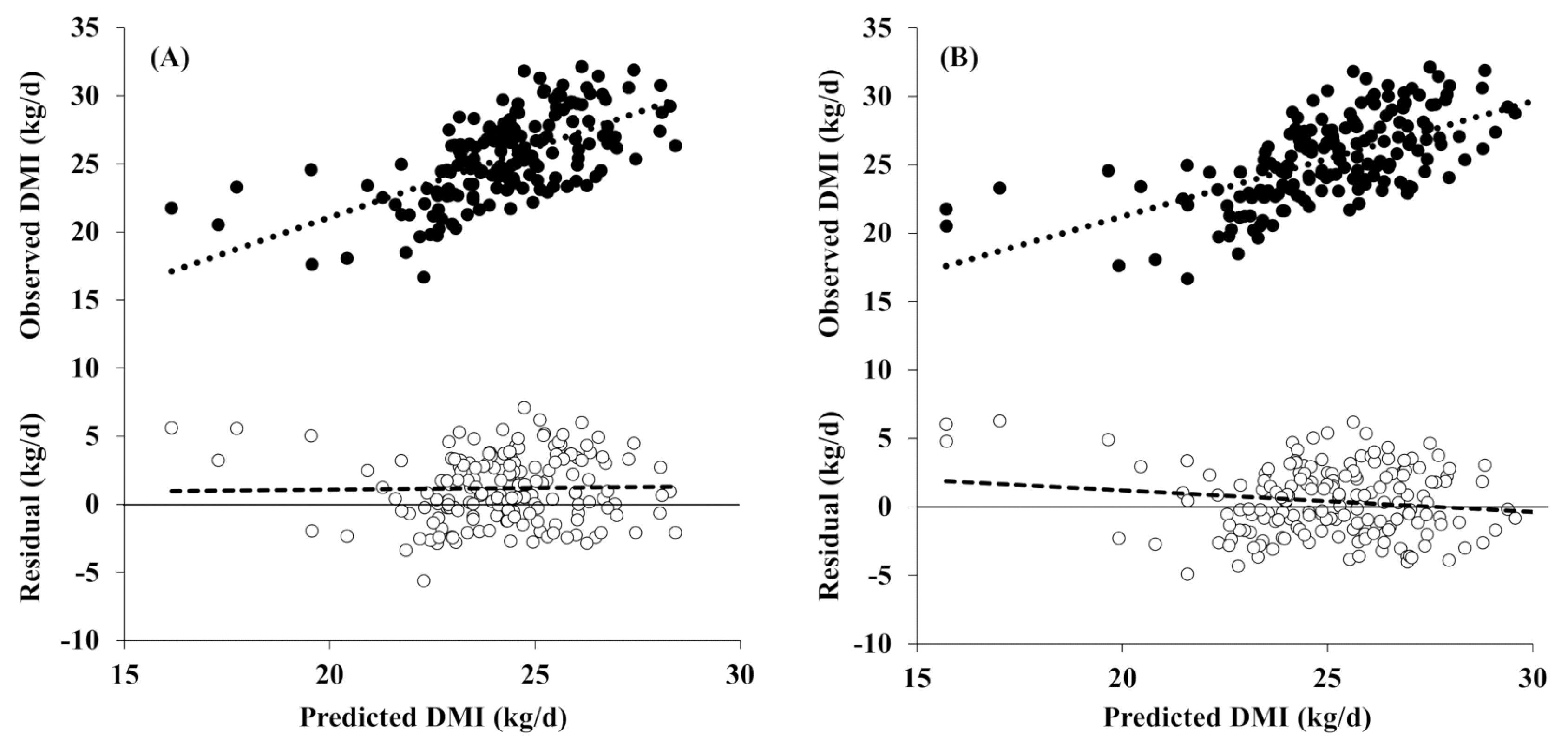 |
 |
| Anim Biosci > Volume 34(10); 2021 > Article |
|
Abstract
Objective
Methods
Results
ACKNOWLEDGMENTS
Figure 1

Figure 2

Figure 3

Table 1
SD, standard deviation; BW, body weight; DMI, dry matter intake; DMIpBW, dry matter intake as a percentage of body weight; MY, milk yield; FCM, fat-corrected milk; FpDM, forage as a percentage of the dietary dry matter; CP, crude protein; EE, ether extract; NDF, neutral detergent fiber; ADF, acid detergent fiber.
Table 2
Table 3
| Model1) | Equation2) |
|---|---|
| NRC Lag[x]3) | (0.372×FCM+0.0968×BW0.75)×Lag[x] |
| CNCPS Lag[x]3) | (0.0185×BW+0.305×FCM)×Lag[x] |
| JFS |
Multiparous 1.3922+0.05839×BW0.75+0.40497×FCM×[1.0−0.3531×exp(−0.3247×WOL)] Primiparous 1.9120+0.07031×BW0.75+0.34923×FCM×[1.3671−0.6558×exp(−0.0498×WOL)] |
1) NRC, National Research Council [1]; CNCPS, Cornell Net Carbohydrate and Protein System [10]; JFS, Japanese feeding standard for dairy cattle [11].
3) Lag[x] is the lag function for adjusting the DMI reduction during the first 16 weeks of lactation when the peak milk yield occurs on the x month of lactation [2]. Lag[2] = 1−exp(−0.316×[WOL+2.36]), Lag[3] = 1−exp(−0.192×[WOL+3.67]).
Table 4
| Nutrients | Total mixed ration | Concentrate mix |
|---|---|---|
| DM (g/kg as fed) | 510 | 883 |
| CP | 125 | 217 |
| EE | 47 | 48 |
| CF | 224 | 89 |
| Ash | 65 | 77 |
| NDF | 432 | 288 |
| ADF | 245 | 143 |
| Ca | 7 | 11 |
| P | 4 | 6 |
| TDN | 698 | 778 |
| NEl (MJ/kg DM) | 6.7 | 7.5 |
Table 5
Table 6
| Model1) | Linear regression | Bias | ||||||
|---|---|---|---|---|---|---|---|---|
|
|
|
|||||||
| Intercept | Slope | R2 | RMSPE2) | Mean | p-value | Slope | p-value | |
| KFSD | 1.04 | 0.95 | 0.47 | 2.70 | −0.122 | 0.56 | −0.051 | 0.51 |
| NRC (2001) | 5.32 | 0.77 | 0.46 | 2.83 | 0.236 | 0.23 | −0.229 | <0.01 |
| CNCPS | 2.99 | 0.94 | 0.48 | 3.13 | 1.629 | <0.01 | −0.065 | 0.39 |
| NRC Lag[2]3) | 3.51 | 0.82 | 0.48 | 2.80 | −0.563 | <0.01 | −0.177 | <0.01 |
| CNCPS Lag[3]3) | 5.26 | 0.86 | 0.46 | 3.62 | 2.347 | <0.01 | −0.145 | <0.05 |
| JFS | 5.52 | 0.8 | 0.44 | 3.09 | 1.206 | <0.01 | −0.203 | <0.01 |
1) KFSD, equation developed in this study; NRC, National Research Council [1]; CNCPS, Cornell Net Carbohydrate and Protein System [10]; JFS, Japanese feeding standard for dairy cattle [11].
3) Lag[x] is the lag function for adjusting the DMI reduction during the first 16 weeks of lactation when the peak milk yield occurs on the x month of lactation [2]. Lag[2] = 1−exp(−0.316×[WOL+2.36]), Lag[3] = 1−exp(−0.192×[WOL+3.67]). WOL, week of lactation.
Table 7
| Model1),2) | Linear regression | Bias | ||||||
|---|---|---|---|---|---|---|---|---|
|
|
|
|||||||
| Intercept | Slope | R2 | RMSPE3) | Mean | p-value | Slope | p-value | |
| Overall | ||||||||
| KFSD | 0.52 | 1.03 | 0.39 | 2.71 | 1.19 | <0.01 | 0.03 | 0.78 |
| NRC (2001) | 4.35 | 0.84 | 0.37 | 2.53 | 0.41 | 0.03 | −0.16 | 0.06 |
| Cold season | ||||||||
| KFSD | 3.80 | 0.94 | 0.46 | 3.12 | 2.34 | <0.01 | −0.06 | 0.63 |
| NRC (2001) | 7.99 | 0.75 | 0.45 | 2.71 | 1.61 | <0.01 | −0.25 | 0.02 |
| Warm season | ||||||||
| KFSD | −0.32 | 1.03 | 0.37 | 2.43 | 0.46 | 0.05 | 0.03 | 0.81 |
| NRC (2001) | 2.30 | 0.89 | 0.37 | 2.40 | −0.34 | 0.15 | −0.11 | 0.35 |
1) Data from March to June except for February (n = 173); Cold season, data from November to January (n = 67); Warm season, data from March to June (n = 106).
2) KFSD, equation developed in this study; NRC, National Research Council [1].
REFERENCES
- TOOLS
-
METRICS

-
- 0 Crossref
- 1 Scopus
- 4,647 View
- 228 Download
- Related articles






 PDF Links
PDF Links PubReader
PubReader ePub Link
ePub Link Full text via DOI
Full text via DOI Download Citation
Download Citation Print
Print




